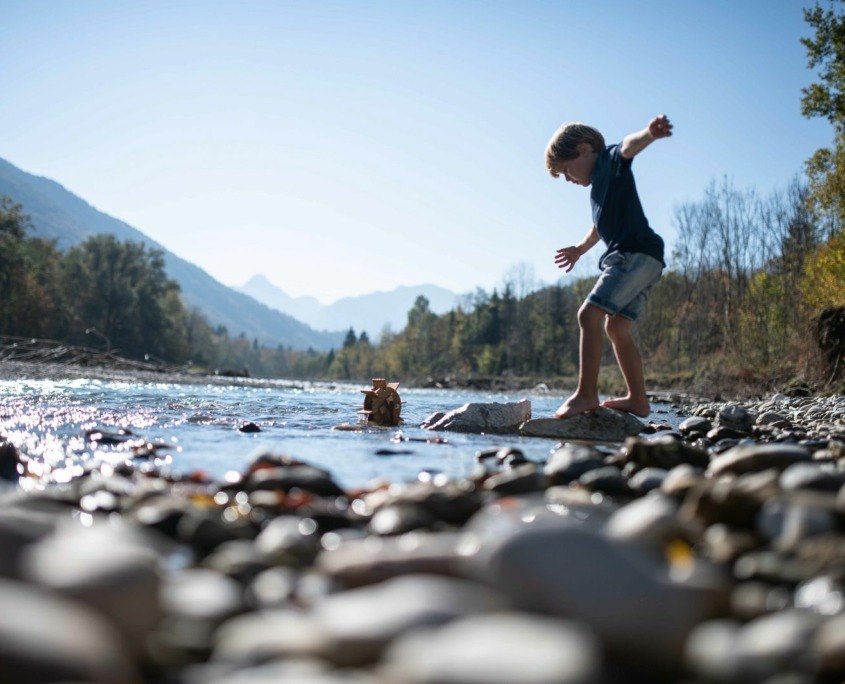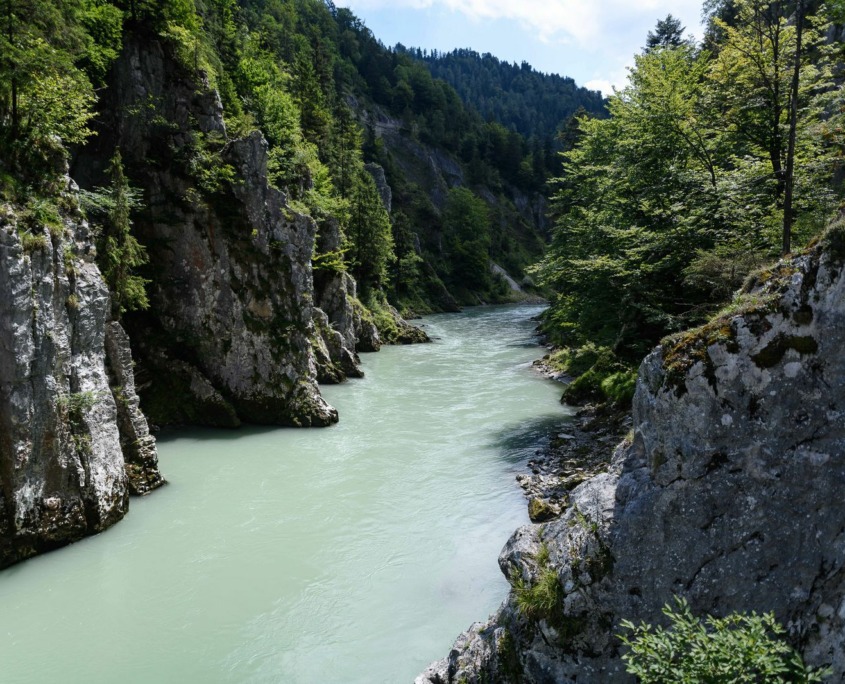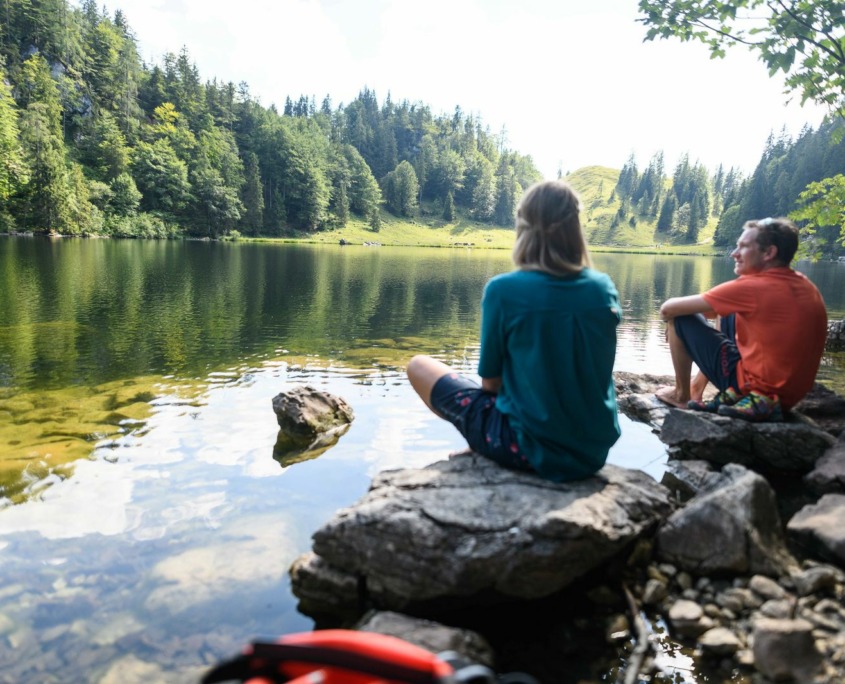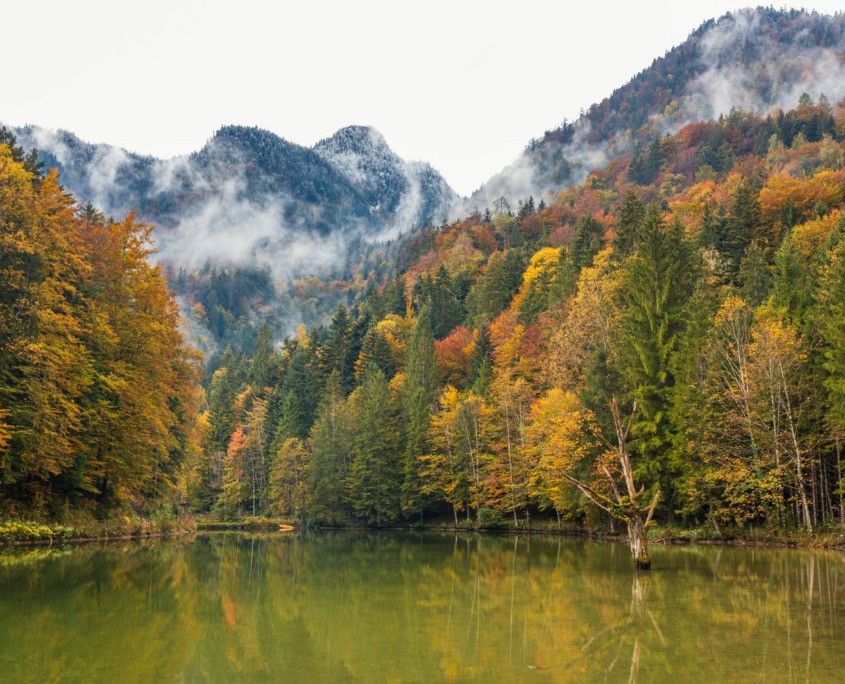Water sports in the Achental
ENJOY A REFRESH

ENJOY A REFRESH
Fun for the whole family
Paddle through the specatular Entenlochklamm, a breathtaking gorge, while rafting, immerse yourself in a packraft adventure or discover the Tiroler Ache by kayak.

FASCINATING NATURAL EXPERIENCE
Nothing characterizes the landscape of the Achental as much as the course of the turquoise-blue Tiroler Ache. Over 79 kilometers the Ache makes its way from the Kitzbühel Alps to Lake Chiemsee and breaks through the Chiemgau Alps, surrounded by steep rock faces.
As the largest tributary of Lake Chiemsee, the wild mountain river flows into the lake through the Achendelta near the village of Grabenstätt. The estuary is an inland delta that is unique in Central Europe and it is constantly changing.
The gravel banks along the Tiroler Ache and the estuary delta are valuable habitats for rare water birds and gravel breeders.

A specatular natural spectacle is the Entenlochklamm – a 2.5 kilometer long rocky narrow passage between Kössen and Schleching, which the Tiroler Ache passes to flow to Bavaria.
The impressive gorge is spanned by two suspension bridges which you can explore along the Smuggler’s Trail (Schmugglerweg). Or you can discover the Alpine canyon by kayak or rubber dinghy.
The Bavarian part of the gorge, the breakthrough valley of the Tiroler Ache, has been a large nature reserve since 1982.

The picturesque Taubensee is one of the highest mountain lakes in Germany. Located in the middle of the Chiemgau Alps at 1,140 meters, the mountain lake with its diverse shore sections invites you to take a relaxing hiking break.
It owes its name by the stone crabs, “Daubben” in Bavarian, which are native to the lake alongside numerous species of fish, frogs and mussels. The dark blue color and oval shape have also earned Lake Taubensee the nickname “Eye of the Chiemgau”. The Border between Bavaria and Tyrol runs right through the middle of the lake, which is up to 40 meters deep.

The Lake Rudersburger See near Schleching is particularly idyllic. The surrounding mountain forest is reflected in the smooth surface of the lake, creating the most beautiful images. While the small oasis shimmers in a variety of shades of green in summer, autumn transforms Lake Rudersburger See into a brightly colored scene.
At Lake Rudersburger See you can not only take a deep breath and enjoy a break surrounded by nature, but also go fishing.

treading water
Treading water is probably the most famous application according to naturopath and pastor Sebastian Kneipp. In the Achental there are not only several Kneipp pools that invite you to tread water, but also the Wössner Bach which is considered the longest Kneipp facility in Germany. The Kneipp hiking trail around the Mountaineering Village of Schleching also entices you to take a refreshing excursion into nature.
Nature, relaxation and sport
Enjoy the wonderful nature and maybe land a big fish: The diversity of fish species in the waters of the Achental and the Chiemgau region offer anglers and sport fishermen the best conditions. While the Tiroler Ache and the nearby river Traun are popular for fly fishing, anglers at the Taubensee and the Rudersburger See find great opportunities to cast the hook far away in peace and quiet.
If you want to spend a relaxing fishing holiday in the Achental, you need a valid fishing license and a fishing permit. Depending on the fishing area, this can be obtained, for example, from the Chiemsee Sport Fishing Association (Sportangelbund Chiemsee) or from the fishing lake owner.
Wild water and the Entenlochklamm
Rafting on the Tiroler Ache is an experience – even on rainy days! You can book the family-friendly rafting tour daily from the mid of May until the mid of October. From Kössen in Tyrol you go on a guided tour by a rubber dinghy through the breathtaking Entenlochklamm, an Alpine canyon, to Schleching – and if you dare, you can jump into the refreshing water wearing a wetsuit.

By loading the video, you agree to YouTube's privacy policy.
Learn more
Achental - Chiemsee-Chiemgau holiday region
We firmly believe that the internet should be available and accessible to anyone, and are committed to providing a website that is accessible to the widest possible audience, regardless of circumstance and ability.
To fulfill this, we aim to adhere as strictly as possible to the World Wide Web Consortium’s (W3C) Web Content Accessibility Guidelines 2.1 (WCAG 2.1) at the AA level. These guidelines explain how to make web content accessible to people with a wide array of disabilities. Complying with those guidelines helps us ensure that the website is accessible to all people: blind people, people with motor impairments, visual impairment, cognitive disabilities, and more.
This website utilizes various technologies that are meant to make it as accessible as possible at all times. We utilize an accessibility interface that allows persons with specific disabilities to adjust the website’s UI (user interface) and design it to their personal needs.
Additionally, the website utilizes an AI-based application that runs in the background and optimizes its accessibility level constantly. This application remediates the website’s HTML, adapts Its functionality and behavior for screen-readers used by the blind users, and for keyboard functions used by individuals with motor impairments.
If you’ve found a malfunction or have ideas for improvement, we’ll be happy to hear from you. You can reach out to the website’s operators by using the following email
Our website implements the ARIA attributes (Accessible Rich Internet Applications) technique, alongside various different behavioral changes, to ensure blind users visiting with screen-readers are able to read, comprehend, and enjoy the website’s functions. As soon as a user with a screen-reader enters your site, they immediately receive a prompt to enter the Screen-Reader Profile so they can browse and operate your site effectively. Here’s how our website covers some of the most important screen-reader requirements, alongside console screenshots of code examples:
Screen-reader optimization: we run a background process that learns the website’s components from top to bottom, to ensure ongoing compliance even when updating the website. In this process, we provide screen-readers with meaningful data using the ARIA set of attributes. For example, we provide accurate form labels; descriptions for actionable icons (social media icons, search icons, cart icons, etc.); validation guidance for form inputs; element roles such as buttons, menus, modal dialogues (popups), and others. Additionally, the background process scans all the website’s images and provides an accurate and meaningful image-object-recognition-based description as an ALT (alternate text) tag for images that are not described. It will also extract texts that are embedded within the image, using an OCR (optical character recognition) technology. To turn on screen-reader adjustments at any time, users need only to press the Alt+1 keyboard combination. Screen-reader users also get automatic announcements to turn the Screen-reader mode on as soon as they enter the website.
These adjustments are compatible with all popular screen readers, including JAWS and NVDA.
Keyboard navigation optimization: The background process also adjusts the website’s HTML, and adds various behaviors using JavaScript code to make the website operable by the keyboard. This includes the ability to navigate the website using the Tab and Shift+Tab keys, operate dropdowns with the arrow keys, close them with Esc, trigger buttons and links using the Enter key, navigate between radio and checkbox elements using the arrow keys, and fill them in with the Spacebar or Enter key.Additionally, keyboard users will find quick-navigation and content-skip menus, available at any time by clicking Alt+1, or as the first elements of the site while navigating with the keyboard. The background process also handles triggered popups by moving the keyboard focus towards them as soon as they appear, and not allow the focus drift outside it.
Users can also use shortcuts such as “M” (menus), “H” (headings), “F” (forms), “B” (buttons), and “G” (graphics) to jump to specific elements.
We aim to support the widest array of browsers and assistive technologies as possible, so our users can choose the best fitting tools for them, with as few limitations as possible. Therefore, we have worked very hard to be able to support all major systems that comprise over 95% of the user market share including Google Chrome, Mozilla Firefox, Apple Safari, Opera and Microsoft Edge, JAWS and NVDA (screen readers).
Despite our very best efforts to allow anybody to adjust the website to their needs. There may still be pages or sections that are not fully accessible, are in the process of becoming accessible, or are lacking an adequate technological solution to make them accessible. Still, we are continually improving our accessibility, adding, updating and improving its options and features, and developing and adopting new technologies. All this is meant to reach the optimal level of accessibility, following technological advancements. For any assistance, please reach out to
